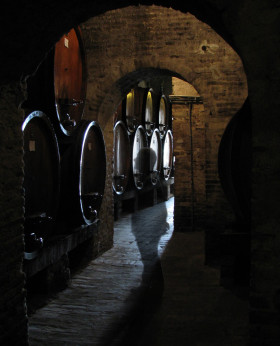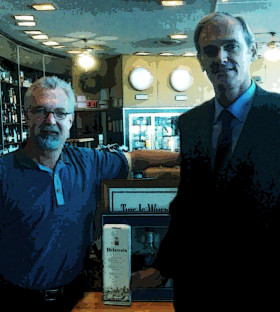The Angel’s Share. It Will Be Mist.
Chapter Thirteen, Part Five.
 Centuries ago, Cognac producers learned that impermeable oak barrels were very good for keeping spirits in, but not very good at keeping spirits out. When cellarmasters discovered their precious product was disappearing from the barrels locked in their basements, they came to the logical conclusion that angels must be visiting the cellars and drinking from the heavenly casks. The missing portion became known as “la part des anges” or the “angel’s share”. I think most Cognac producers believe the 2% to 4% that disappears every year is fair compensation for the angel’s empyrean influence on their maturing brandy.
Centuries ago, Cognac producers learned that impermeable oak barrels were very good for keeping spirits in, but not very good at keeping spirits out. When cellarmasters discovered their precious product was disappearing from the barrels locked in their basements, they came to the logical conclusion that angels must be visiting the cellars and drinking from the heavenly casks. The missing portion became known as “la part des anges” or the “angel’s share”. I think most Cognac producers believe the 2% to 4% that disappears every year is fair compensation for the angel’s empyrean influence on their maturing brandy.
Two to four percentage points might not seem like much but it adds up over time. A single Cognac cask holds 263 bottles when full. Sixty years later the angel’s share will reduce that by 83 bottles, or approximately half the Cognac Busta Rhymes and Snoop Doggy Dog drink on Tuesday night. On the bright side, Cognac producers don’t have to pay tax on the missing spirit, leaving me to wonder; what does a line item deduction for angel’s consumption look like on a tax return?
I asked Charles Braastad, the man who crafts the remarkable Cognacs from the House of Delamain (and is the son of Alain Braastad-Delamain, the man who taught me how to “nose” a fine spirit 18 years earlier), about the genesis of the expression “la part des anges”. While there doesn’t seem to be any record of who first coined the phrase, Braastad said he had recently read that angel was the name given to a volatile substance in alchemy. Sacre bleu! Could this romantic phrase actually be an ancient scientific reference to evaporation?
Braastad gave me the impression that the angel’s share disappearing from Delamain’s casks had more to do with the local church than with ancient alchemy. “I can tell you that Delamain’s 18th century cellars have been built against our 1010 year-old local church,” he explained, “so our angels don’t have a long trip to come and take their share from our old casks.”
In 2011, the 200 year-old bourbon producer Jim Beam discovered that, in addition to forfeiting the angel’s share, the barrel itself also retained a portion of their cherished bourbon. They called the whiskey trapped inside the oak staves the devil’s cut.
This phenomenon explains the high demand for used barrels by astute distillers and brewers around the world. In Scotland, used Sherry casks have long been prized for the sweet notes they impart to single malt scotch. In the past fifteen years there has been an explosion of experimental malt whiskies that are “finished” in barrels that once held wines such as Sauternes and port, or spirits like rum and bourbon. Used bourbon casks are also cherished by small craft breweries that use them to create unique bourbon-aged brews.
In the case of the Jim Beam Distillery, Fred Booker Noe III, master distiller and seventh generation descendant of Jim Beam, drew the line at giving the devil his due. He developed a proprietary process to exorcise the reluctant spirit from the oak. This robust extract was then blended with 6 year-old bourbon and bottled under the name Devil’s Cut.
Apparently angels aren’t picky about what they drink because they take their share from barrels containing Cognac, scotch, bourbon, rye, tequila, and of course wine. As water and alcohol evaporate, unpleasant odors are released through the porous oak while pleasing aromas and flavors are added and concentrated. In low humidity cellars most of what evaporates is water. Where the humidity is higher, more alcohol evaporates, reducing the strength of the finished wine but increasing the joy of the angels.
Time spent in cask integrates the tannins, acidity, fruit, alcohol, and oak flavors, assimilating the wine into a unified beverage. At the same time, barrel aging has a softening effect on the texture of wine. The slow oxidation occurring inside a barrel offsets the astringent tannins imparted by the stems, seeds and skins of the grapes and from the barrel itself. Initially a barrel may impart harsh tannins to wine, but oddly enough the cure for this dilemma is to leave the wine in the barrel longer. With time the mellowing effect of oxidation, made possible by oak’s permeability, overcomes any astringency imparted by the barrel.
It’s the porous quality of oak that creates the pervious pearly gates through which the angels take their share. And take they do. Charles Braastad explained that in the Cognac region alone, la part des anges is estimated at over 20 million bottles a year, which probably explains why so many angels miss work on Monday.





















